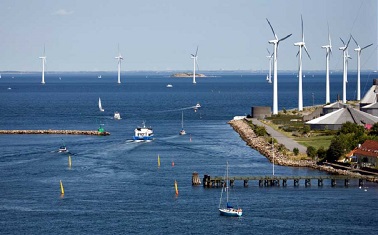I look out the window of the crowded Scandinavian Airlines plane – bleary-eyed after a sleepless, 8-hour flight – as it makes its final approach to the Copenhagen airport one recent morning.
The first thing I see are the wind turbines that hug the coast, spinning steadily like white jewels against the blue water. For a moment I wonder if I’m hallucinating.
What are wind turbines doing so close to civilization and adjacent to Denmark’s main airport?
Back in the United States, I have to travel far beyond my Washington suburb to spot any signs of wind energy. In Denmark, it’s ever-present.
You can’t drive more than a few kilometers on the country’s flat roads without seeing a turbine. They are fully integrated into society and part of the landscape everywhere.
And that’s not by accident.
From zero to 30% renewables in 30 years. How?
During my 10-day visit with my brother and his Danish family at the end of July, I witnessed a society where the political debate isn’t over a “war on coal” or whether climate change is real. I saw a society that has proudly and vigorously embraced the clean energy future and is racing toward it.
Accelerating from nearly zero percent as recently as the mid-80s, wind power now provides about 30 percent of Denmark’s electricity. And the Danes aren’t done. They have plans to grow that number to 50 percent by 2020 and to be 100 percent renewable by 2050.
All of this – and more – is possible here in the United States, too, believe it or not. We enjoy some of the world’s best wind and solar resources.
But despite our rapid wind and solar energy growth in recent years, we’ve only just begun to tap these clean energy treasures.
So how did Denmark manage to ramp up clean energy when we’re just getting started?
One: Wind energy was made a national priority
Denmark’s clean energy progress began in response to the oil crises of the 1970s. In 1973, the year I was born, 95 percent of Denmark’s energy consumption was based on imported oil. Initially, Denmark responded to the 1973 and 1979 oil crises by transitioning to coal, which still generates about half of Denmark’s electricity.
Then, the Danish government saw an opportunity to build a new industry. Through a combination of national policies and subsidies, and in concert with local communities and utilities, the country made wind energy a national priority. By 1990, Danish wind energy was ready to explode.
Two: Subsidies allowed market to grow
Denmark introduced a fixed feed-in tariff in 1993 to make installation of wind power competitive, an economic incentive that allowed the market to grow. Danish wind projects also received a refund from the Danish carbon tax, and a partial refund on the nation’s energy tax.
The cumulative effect of these refunds doubled the payment to wind projects for the first five years of their operations, according to the International Renewable Energy Agency. By 2000, Danish wind capacity had increased more than seven-fold to 2,390 megawatts.
Eight years later, the Danish government developed an energy agreement that included the installation of two big offshore wind farms of 200 megawatts each.
Three: Consumers helped pay for wind
In 2009, Denmark introduced an environmental premium of $0.05/kWh and added a $0.004/kWh compensation to balance the costs of wind energy.
It meant that consumers paid for the costs of connecting offshore wind farms, with financing managed by the Danish Energy Agency. As a result of these policies, wind energy continues to grow in Denmark, bringing its goal of 100-percent renewables by 2050 within sight.
If the Danes can do it, so can we
This takes us back to the U.S., a nation that has historically led the world on innovation and economic leadership.
Over the last five years, net solar electricity generation increased more than 10 times. Net wind electricity more than doubled, making the U.S. one of the fastest-growing wind energy markets in the world.
And yet, wind accounts for just 5 percent of our energy and solar less than 1 percent. This is unfortunate, considering that we have enough wind energy potential in the lower 48 alone to power America’s current electricity consumption nine times over, according to the National Renewable Energy Laboratory.
The NREL also estimates that our total solar potential is an astounding 100 times greater than our current electricity consumption.
Just imagine what we could do if our political leaders had the same vision as the Danes. Imagine where we could be in 10 or 20 years if we looked to Denmark as a model for fully integrating government leadership with local communities and utilities.
Thanks to the Danish experiment, we have a blueprint. And this American environmentalist is inspired and eager to see the Danish model spread.
By Sam Parry
Originally Published on August 12, 2014
The Energy Exchange Blog is a forum where EDF‘s energy experts discuss how to accelerate the transition to a clean, low-carbon energy economy. Follow them on Twitter here: @EDFEnergyEX.

